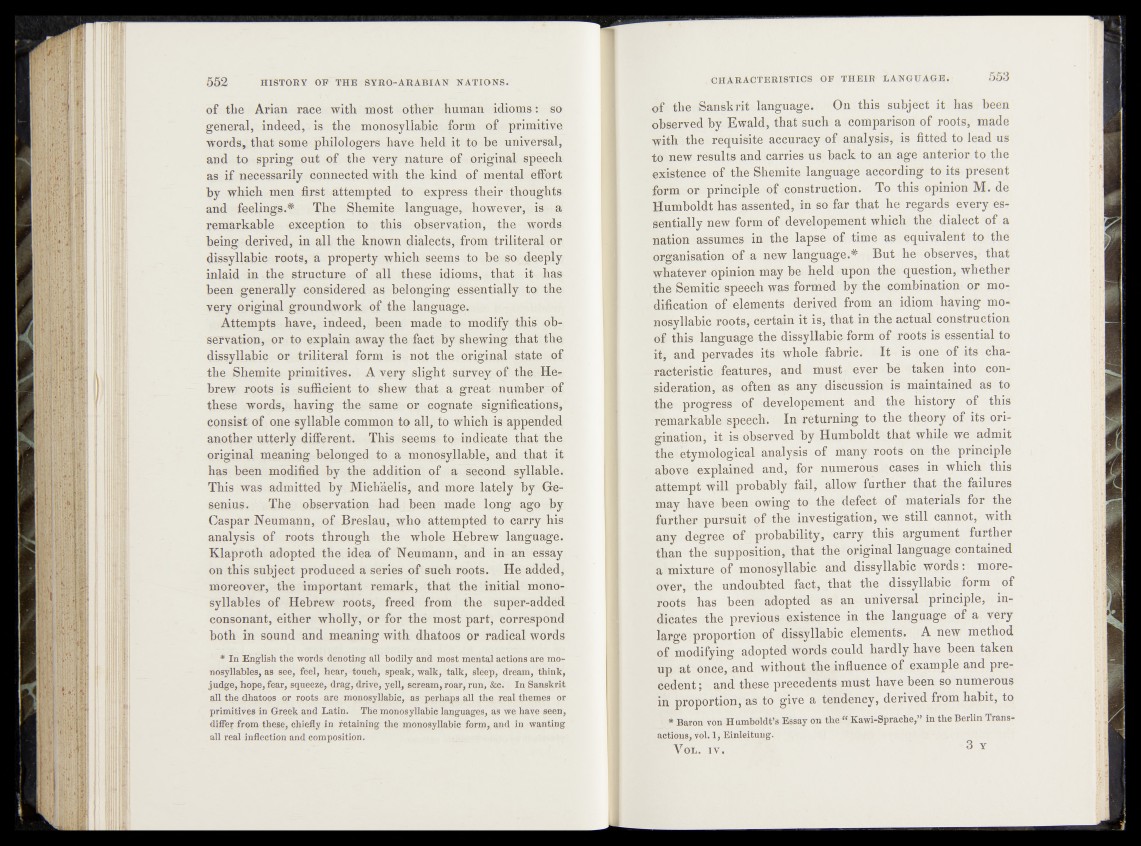
of tlie Arian race with most other human idioms: so
general, indeed,; is the monosyllabic form of primitive
words, that some philologers have held it to he universal?
and to spring out of the very nature of original speech
as if necessarily connected with the kind of mental effort
by which men first attempted to express their thoughts
and feelings.* The ^hemite language, however, is a
remarkable exception to this observatiobi th^fewords
being derived, in all the known dialects, from triliteral or
dissyllabic roots, a property which seems :to he so deeply
inlaid in-the Structure of all these idioms, that, it has
been generally considered as belonging essentially to the
very original groundwork of the language.
Attempts have, indeed, been made to modify this observation,
or to explain away the faet by shewingthatthe
dissyllabic or triliteral form is not the original state of
the Shemite primitives. A very slight survey-of; the He?
brew roots is sufficient to shew that a great- number of
these words, having the same or cognate significations,
consist of one syllable common to all, to which .is appended
another utterly different. This seems to indicate that the,
original meaning belonged to a monosyllable, and that it
has been modified by the addition of a second syllable.
This was admitted by Michaèlis, and-more.lately by Ge-
senius. The observation had been made long ago by
Caspar Neumann, of Breslau, who attempted to carry his
analysis of roots through the whole Hebrew language.
Klaproth adopted the idea of Neumann, and in an essay
on this subject produced a series of such roots. He added,
moreover, the important remark, that the initial monosyllables
of Hebrew roots, freed from the- super-added
consonant, either wholly, or for thé most part, correspond
both in sound and meaning with dhatoos or radical words
* In English the words denoting all bodily and most mental actions are monosyllables,
as see, feel, hear, touch, speak, walk, talk, sleep, dream, think,
judge, hope, fear, squeeze, drag, drive, yell, scream, roar, run> &c. In Sanskrit
alL the dhatoos or roots are monosyllabic, as perhaps all the real themes or
primitives in Greek and Latin. The monosyllabic languages, as we have seen,
differ from these, chiefly in retaining the monosyllabic form, and in wanting
all real inflection and composition.
of the Sanskrit language. On this subject it has been
observed by Ewald, that such a comparison of roots, made
with the requisite accuracy of: analysis, is fitted to lead us
to new results and carries us hack to an age anterior to the
existence of the Shemite language according to its present
form or principle of .construction. To this opinion M. de
Humboldt has assented, in so far that he regards every essentially
new.form of-developement which, the dialect of a
nation assumes in the lapse of time as equivalent to the
organisation of a new language.* But ho observes, that
whatever opinion may he held upon the question, whether
the Semitic speech was formed by the combination or modification
of elements derived from an idiom having monosyllabic
roots* certain it is, that in the actual construction
of this language the dissyllabic form of roots is essential to
i§y and pervades its whole fabric. It is one of its characteristic
features, and must ever he taken into consideration,
as often as any discussion is maintained as to
the progress of developement- and the history of this
remarkable «speech. In returning to the theory of its origination,
it is observed by Humboldt that while we admit
the etymological analysis of many roots on the principle
above explained and, for numerous cases- in which this
attempt will probably fail, allow further that the failures
may have been owing to ; the defect of materials for the
further pursuit of the investigation, we still cannot, with
any degree of probability, carry this argument further
than thé supposition, that the original language contained
a mixture of monosyllabic and dissyllabic words : moreover,
the undoubted fact, that the dissyllabic form of
roots has been adopted as am universal principle, indicates
the previous existence ip the language of a very
large proportion of dissyllabic elements. A new method
of modifying adopted wor,ds could hardly have been taken
up at once, and without thejnfluence of example and precedent
; and these precedents must have been so numerous
in proportion, as to give a tendency, derived from habit, to;
» Baron von Humboldt’s Essay on the “ Kawi-Sprache,” in the Berlin Transactions,
vôl. 1, Einleitung.
VOL. IV. 3 Y